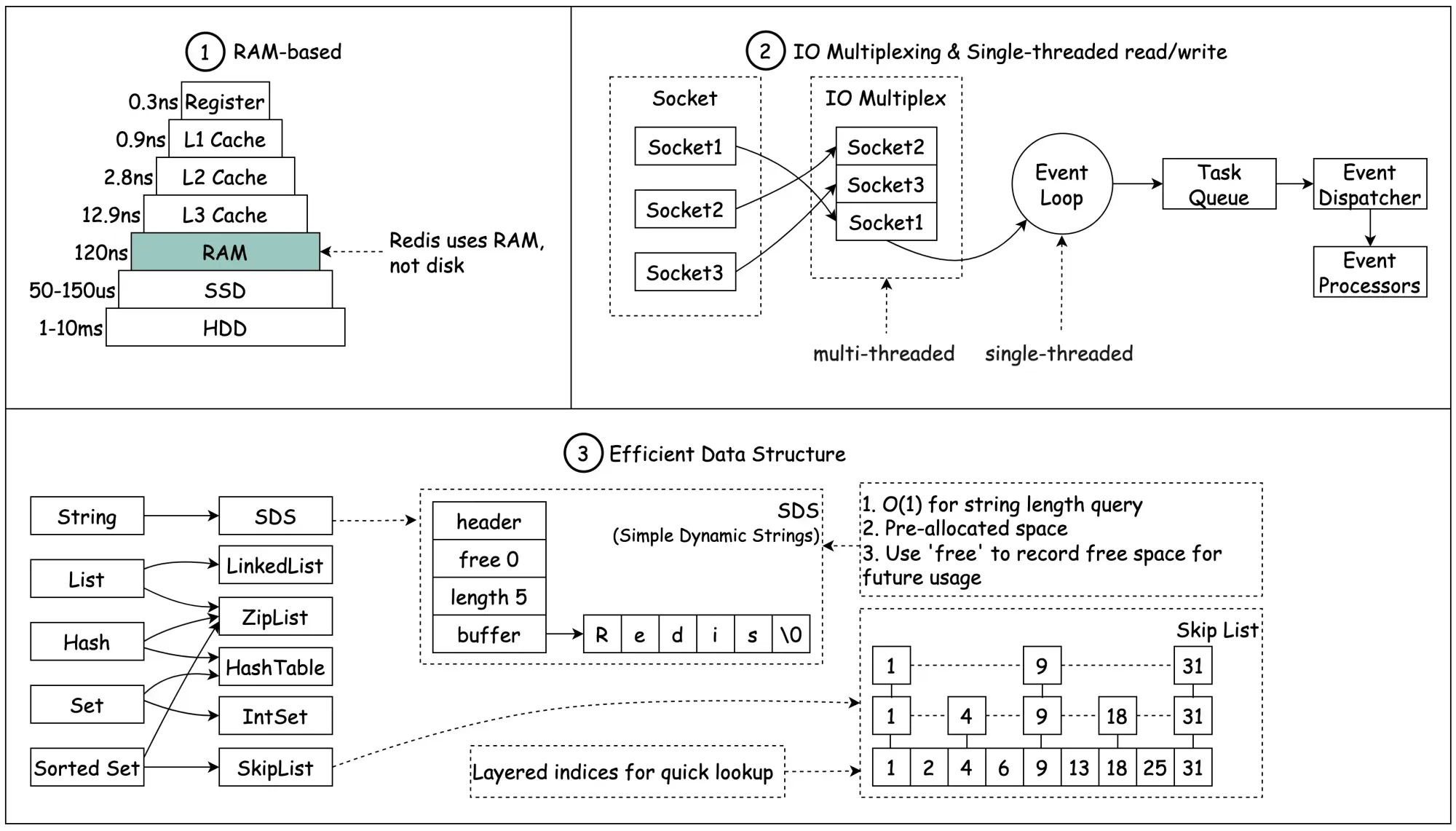Why Redis is So Fast It Will Blow Your Mind!
Find out Why Redis is so fast, even after over a decade since its creation.

Redis is a highly popular in-memory database known for its speed, rock-solid stability, and ease of use. But what makes Redis so fast, even after over a decade since its creation? In this article, we'll take a closer look at its fundamental design decisions that have stood the test of time.
A. What is Redis?
Redis is an in-memory data structure store that supports various data structures such as strings, hashes, lists, sets, and sorted sets. It is most commonly used as a cache, and it is known for its speed.
Redis is a RAM-based database. RAM access is at least 1000 times faster than random disk access.
B. Why Redis is so Fast?
A Look at Its Fundamental Design Decisions

Redis is a highly popular in-memory database known for its speed, rock-solid stability, and ease of use. In fact, it has consistently been ranked as one of the most loved databases according to Stack Overflow's annual developer survey. But what makes Redis so fast, even after over a decade since its creation? In this article, we'll take a closer look at its fundamental design decisions that have stood the test of time.
1. In-Memory Database
High Read and Write Throughput with Low Latency
One of the main reasons Redis is fast is because it is an in-memory database. As memory access is several orders of magnitude faster than random disk I/O, pure memory access provides high read and write throughput with low latency. However, a trade-off of this approach is that the dataset cannot be larger than memory. Nevertheless, in-memory data structures are easier to implement than their on-disk counterparts, which keeps Redis' code simple and contributes to its rock-solid stability.
2. Single-Threaded Design
Simplified and Stable
Another reason Redis is fast is because of its single-threaded design, which is somewhat unintuitive. You might think that using multiple threads to leverage all the CPU cores would be faster. However, multi-threaded applications require locks or other synchronization mechanisms, which are notoriously difficult to reason about. In many cases, this added complexity is bug-prone and sacrifices stability, making it difficult to justify the performance gain.
On the other hand, the single-threaded code path of Redis is easy to understand. And with I/O multiplexing, the operating system allows a single thread to wait on many socket connections simultaneously. This is done through the use of I/O multiplexing with the select or poll system calls, which traditionally are not very performant when there are many thousands of connections. However, on Linux, epoll is a performant variant of I/O multiplexing that supports many thousands of connections in constant time.
3. Efficient Low-Level Data Structures
The third reason Redis is fast is that it leverages efficient low-level data structures without worrying about how to persist them to disk efficiently. Linked lists, skip lists, and hash tables are some examples of these data structures. With Redis being an in-memory database, it can use these data structures without any concern about their persistence on disk.

Top 5 Use Cases of Redis
1. Caching Objects
Caching objects to speed up web applications is the number one use case of Redis. Frequently requested data is stored in memory, which allows web servers to return frequently accessed data quickly. This reduces the load on the database and improves the response time of the application.
At scale, the cache is distributed among a cluster of Redis servers. Sharding is a common technique to distribute the caching load evenly across the cluster. Other topics to consider when deploying Redis as a distributed cache include setting a correct TTL and handling a thundering herd on cold start.
2. Session Store
Redis can be used as a session store to share session data among stateless servers. When a user logs in to a web application, the session data is stored in Redis, along with a unique session ID that is returned to the client as a cookie. When the user makes a request to the application, the session ID is included in the request, and the stateless web server retrieves the session data from Redis using the ID.
However, it is important to note that Redis is an in-memory database, so the session data stored in Redis will be lost if the Redis server restarts. In production, replication is usually used instead, where data is replicated to a backup instance. In the event of a crash of the main instance, the backup is quickly promoted to take over the traffic.
3. Distributed Lock
Distributed locks are used when multiple nodes in an application need to coordinate access to some shared resource. Redis is used as a distributed lock with its atomic commands like SETNX, or SET if Not eXists. It allows a caller to set a key only if it does not already exist.
For instance, Client 1 tries to acquire the lock by setting a key with a unique value and a timeout using the SETNX command. If the key was not already set, the SETNX command returns 1, indicating that the lock has been acquired by Client 1. If the key was already set, the SETNX command returns 0, indicating that the lock is already held by another client.
In this case, Client 1 waits and retries the SETNX operation until the lock is released by the other client. Note that this simple implementation might be good enough for many use cases, but it is not completely fault-tolerant. For production use, many Redis client libraries provide high-quality distributed lock implementations built out of the box.
4. Rate Limiter
Redis can be used as a rate limiter by using its increment command on some counters and setting expiration times on those counters. A very basic rate-limiting algorithm works this way: for each incoming request, the request IP or user ID is used as a key.
The number of requests for the key is incremented using the INCR command in Redis. The current count is compared to the allowed rate limit. If the count is within the rate limit, the request is processed. If the count is over the rate limit, the request is rejected. The keys are set to expire after a specific time window, e.g., a minute, to reset the counts for the next time window
5. Gaming Leaderboard
For most games that are not super high scale, Redis is a delightful way to implement various types of gaming leaderboards. Sorted Sets are the fundamental data structure that enables this. A Sorted Set is a collection of unique elements, each with a score associated with it.
The elements are sorted by their score in ascending or descending order. In a gaming leaderboard, each player has a unique ID, and their score is updated regularly. The player ID is used as the Sorted Set member, and the score is used as the score associated with that member. The Sorted Set can then be queried to retrieve the top players or to find the player's rank. Redis provides atomic commands to update the score of an element in the Sorted Set, making it easy to maintain the leaderboard.
Overall, Redis is a powerhouse in the world of in-memory databases. Its speed, stability, and ease of use have made it a favorite among developers. Its impressive performance can be attributed to its in-memory design, single-threaded code path, and efficient use of low-level data structures. While some attempts have been made to create Redis-compatible servers that can squeeze even more performance out of a single server, Redis still provides the best performance and stability tradeoff in the market.



FAQs
How does Redis achieve its speed?
Redis is an in-memory database, which means that data is stored in RAM rather than on disk. This provides much faster read and write throughput and lower latency than traditional disk-based databases. Additionally, Redis is designed to use efficient data structures that are well-suited to in-memory storage, such as linked lists, skip lists, and hash tables.
Why is Redis primarily single-threaded?
Redis' single-threaded design is actually a key factor in its high performance. Single-threaded code paths are generally easier to understand and reason about, and they avoid the synchronization overhead that comes with multi-threaded designs. Additionally, Redis uses I/O multiplexing to allow a single thread to handle many thousands of incoming requests and outgoing responses simultaneously.
Are there any drawbacks to Redis' single-threaded design?
The main drawback of Redis' single-threaded design is that it does not leverage all the CPU cores available in modern hardware. For some workloads, it may be necessary to run multiple Redis instances on a single server to utilize more CPU cores. However, for most applications, the single-threaded design is sufficient and provides excellent performance and stability.
How can I get started with Redis?
There are many resources available for getting started with Redis, including official documentation, tutorials, and community forums. To use Redis, you will need to download and install it on your system, and then you can begin using the Redis command-line interface or one of the many Redis client libraries available for your programming language of choice.
Reference headlines for this post"
- Redis Revealed: The Secret to Its Blazing-Fast Speed
- Redis: The Lightning-Fast Database Solution You've Been Searching For
- Redis Unlocked: The Surprising Reasons Behind Its Unmatched Performance
- Redis 101: How This In-Memory Database Achieves Lightning-Fast Speeds
- Redis Dissected: An Inside Look at Its Design and Unmatched Speed
- Redis Demystified: How It Achieves Unrivaled Speed and Performance
- Redis Unleashed: How This Single-Threaded Database Powers Blazing-Fast Apps
- Redis Decoded: The Design Choices That Make It So Incredibly Fast
- Redis Explored: The Hidden Factors Behind Its Blazing Speed and Performance
- Redis vs. Other Databases: What Makes Redis So Much Faster?
- Redis is so Fast it will Blow Your Mind!
- Redis: The Fastest Database You've Never Heard Of!
- Redis: The Secret to Insanely Fast Apps
- I Tried Redis and Was Blown Away by Its Speed!
- Redis: The Supercharged Database That Will Revolutionize Your Apps!
- Redis: The Fastest Way to Supercharge Your Apps and Impress Your Friends!
- Redis vs. Other Databases: You Won't Believe How Much Faster it Is!
- Redis: The Lightning-Fast Database Solution That Will Make Your Apps Go Viral!
- Redis: The Database That's So Fast, It's Almost Cheating!
- Redis: The Ultimate Speed Hack for Your Apps!



